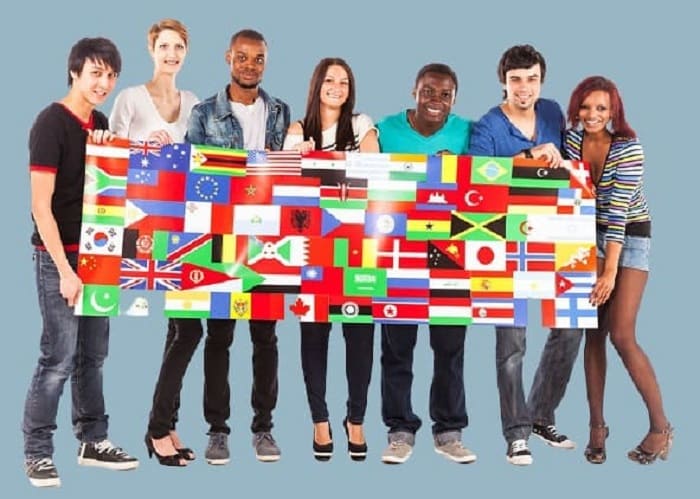There are a lot of languages in the world, a whole lot actually. Ethnologue, the biggest authority on languages on the web, estimates that there are over 7,000 spoken languages in the world.
Check out this list of the most popular languages worldwide to see which language has the most native speakers. You will also find a bit more context on different language families, and how we distinguish between languages.
When we think about world languages, questions quickly come to mind as to what languages are spoken in each country, and what are the most widely spoken languages in the world.
Country |
Recognised Language |
| Afghanistan | Afghan Persian or Dari (official) 77% (Dari functions as the lingua franca), Pashto (official) 48%, Uzbek 11%, English 6%, Turkmen 3%, Urdu 3%, Pashayi 1%, Nuristani 1%, Arabic 1%, Balochi 1% (2017 est.) |
| Albania | Albanian 98.8% (official – derived from Tosk dialect), Greek 0.5%, other 0.6% (including Macedonian, Romani, Vlach, Turkish, Italian, and Serbo-Croatian), unspecified 0.1% (2011 est.) |
| Algeria | Arabic (official), French (lingua franca), Berber or Tamazight (official); dialects include Kabyle Berber (Taqbaylit), Shawiya Berber (Tacawit), Mzab Berber, Tuareg Berber (Tamahaq) |
| Andorra | Catalan (official), French, Castilian, Portuguese |
| Angola | Portuguese 71.2% (official), Umbundu 23%, Kikongo 8.2%, Kimbundu 7.8%, Chokwe 6.5%, Nhaneca 3.4%, Nganguela 3.1%, Fiote 2.4%, Kwanhama 2.3%, Muhumbi 2.1%, Luvale 1%, other 3.6% (2014 est.) |
| Antigua and Barbuda | English (official), Antiguan creole |
| Argentina | Spanish (official), Italian, English, German, French, indigenous (Mapudungun, Quechua) |
| Armenia | Armenian (official) 97.9%, Kurdish (spoken by Yezidi minority) 1%, other 1% (2011 est.) |
| Australia | English 72.7%, Mandarin 2.5%, Arabic 1.4%, Cantonese 1.2%, Vietnamese 1.2%, Italian 1.2%, Greek 1%, other 14.8%, unspecified 6.5% (2016 est.) |
| Austria | German (official nationwide) 88.6%, Turkish 2.3%, Serbian 2.2%, Croatian (official in Burgenland) 1.6%, other (includes Slovene, official in southern Carinthia, and Hungarian, official in Burgenland) 5.3% (2001 est.) |
| Azerbaijan | Azerbaijani (Azeri) (official) 92.5%, Russian 1.4%, Armenian 1.4%, other 4.7% (2009 est.) |
| Bahamas | Azerbaijani (Azeri) (official) 92.5%, Russian 1.4%, Armenian 1.4%, other 4.7% (2009 est.) |
| Bahrain | Arabic (official), English, Farsi, Urdu |
| Bangladesh | Bangla 98.8% (official, also known as Bengali), other 1.2% (2011 est.) |
| Barbados | English (official), Bajan (English-based creole language, widely spoken in informal settings) |
| Belarus | Russian (official) 70.2%, Belarusian (official) 23.4%, other 3.1% (includes small Polish- and Ukrainian-speaking minorities), unspecified 3.3% (2009 est.) |
| Belgium | Dutch (official) 60%, French (official) 40%, German (official) less than 1% |
| Belize | English 62.9% (official), Spanish 56.6%, Creole 44.6%, Maya 10.5%, German 3.2%, Garifuna 2.9%, other 1.8%, unknown 0.3%, none 0.2% (cannot speak) (2010 est.) |
| Benin | French (official), Fon and Yoruba (most common vernaculars in south), tribal languages (at least six major ones in north) |
| Bhutan | Sharchhopka 28%, Dzongkha (official) 24%, Lhotshamkha 22%, other 26% (includes foreign languages) (2005 est.) |
| Bolivia | Spanish (official) 60.7%, Quechua (official) 21.2%, Aymara (official) 14.6%, Guarani (official) 0.6%, other native languages 0.4%, foreign languages 2.4%, none 0.1% (2001 est.) |
| Bosnia and Herzegovina | Bosnian (official) 52.9%, Serbian (official) 30.8%, Croatian (official) 14.6%, other 1.6%, no answer 0.2% (2013 est.) |
| Botswana | Setswana 77.3%, Sekalanga 7.4%, Shekgalagadi 3.4%, English (official) 2.8%, Zezuru/Shona 2%, Sesarwa 1.7%, Sembukushu 1.6%, Ndebele 1%, other 2.8% (2011 est.) |
| Brazil | Portuguese (official and most widely spoken language) |
| Brunei | Malay (Bahasa Melayu) (official), English, Chinese dialects |
| Bulgaria | Bulgarian (official) 76.8%, Turkish 8.2%, Romani 3.8%, other 0.7%, unspecified 10.5% (2011 est.) |
| Burkina Faso | French (official), native African languages belonging to Sudanic family spoken by 90% of the population |
| Burundi | Kirundi only 29.7% (official); French only .3% (official); Swahili only .2%; English only .1% (official); Kirundi and French 8.4%; Kirundi, French, and English 2.4%, other language combinations 2%, unspecified 56.9% (2008 est.)
note: data represent languages read and written by people 10 years of age or older; spoken Kirundi is nearly universal |
| Cambodia | Khmer (official) 96.3%, other 3.7% (2008 est.) |
| Cameroon | 24 major African language groups, English (official), French (official) |
| Canada | English (official) 58.7%, French (official) 22%, Punjabi 1.4%, Italian 1.3%, Spanish 1.3%, German 1.3%, Cantonese 1.2%, Tagalog 1.2%, Arabic 1.1%, other 10.5% (2011 est.) |
| Cape Verde | English (official) 58.7%, French (official) 22%, Punjabi 1.4%, Italian 1.3%, Spanish 1.3%, German 1.3%, Cantonese 1.2%, Tagalog 1.2%, Arabic 1.1%, other 10.5% (2011 est.) |
| Central African Republic | French (official), Sangho (lingua franca and national language), tribal languages |
| Chad | French (official), Arabic (official), Sara (in south), more than 120 different languages and dialects |
| Chile | Spanish 99.5% (official), English 10.2%, indigenous 1% (includes Mapudungun, Aymara, Quechua, Rapa Nui), other 2.3%, unspecified 0.2% (2012 est.) |
| China | Standard Chinese or Mandarin (official; Putonghua, based on the Beijing dialect), Yue (Cantonese), Wu (Shanghainese), Minbei (Fuzhou), Minnan (Hokkien-Taiwanese), Xiang, Gan, Hakka dialects, minority languages (see Ethnic groups entry) |
| Colombia | Spanish (official) |
| Comoros | Arabic (official), French (official), Shikomoro (official; a blend of Swahili and Arabic) (Comorian) |
| Congo, Democratic Republic of the | French (official), Lingala (a lingua franca trade language), Kingwana (a dialect of Kiswahili or Swahili), Kikongo, Tshiluba |
| Congo, Republic of | French (official), Lingala (a lingua franca trade language), Kingwana (a dialect of Kiswahili or Swahili), Kikongo, Tshiluba |
| Costa Rica | Spanish (official), English |
| Cte d’Ivoire | French (official), 60 native dialects of which Dioula is the most widely spoken |
| Croatia | Croatian (official) 95.6%, Serbian 1.2%, other 3% (including Hungarian, Czech, Slovak, and Albanian), unspecified 0.2% (2011 est.) |
| Cuba | Spanish (official) |
| Cyprus | Greek (official) 80.9%, Turkish (official) 0.2%, English 4.1%, Romanian 2.9%, Russian 2.5%, Bulgarian 2.2%, Arabic 1.2%, Filipino 1.1%, other 4.3%, unspecified 0.6% (2011 est.) |
| Czech Republic | Greek (official) 80.9%, Turkish (official) 0.2%, English 4.1%, Romanian 2.9%, Russian 2.5%, Bulgarian 2.2%, Arabic 1.2%, Filipino 1.1%, other 4.3%, unspecified 0.6% (2011 est.) |
| Denmark | Danish, Faroese, Greenlandic (an Inuit dialect), German (small minority) |
| Djibouti | French (official), Arabic (official), Somali, Afar |
| Dominica | English (official), French patois |
| Dominican Republic | Spanish (official) |
| East Timor | Spanish (official) |
| Ecuador | Spanish (Castilian) 93% (official), Quechua 4.1%, other indigenous 0.7%, foreign 2.2% (2010 est.) |
| Egypt | Arabic (official), Arabic, English, and French widely understood by educated classes |
| El Salvador | Spanish (official), Nawat (among some Amerindians) |
| Equatorial Guinea | Spanish (official) 67.6%, other (includes Fang, Bubi, Portuguese (official), French (official)) 32.4% (1994 census) |
| Eritrea | Tigrinya (official), Arabic (official), English (official), Tigre, Kunama, Afar, other Cushitic languages |
| Estonia | Estonian (official) 68.5%, Russian 29.6%, Ukrainian 0.6%, other 1.2%, unspecified 0.1% (2011 est.) |
| Eswatini | English (official, used for government business), siSwati (official) |
| Ethiopia | Oromo (official working language in the State of Oromiya) 33.8%, Amharic (official national language) 29.3%, Somali (official working language of the State of Sumale) 6.2%, Tigrigna (Tigrinya) (official working language of the State of Tigray) 5.9%, Sidamo 4%, Wolaytta 2.2%, Gurage 2%, Afar (official working language of the State of Afar) 1.7%, Hadiyya 1.7%, Gamo 1.5%, Gedeo 1.3%, Opuuo 1.2%, Kafa 1.1%, other 8.1%, English (major foreign language taught in schools), Arabic (2007 est.) |
| Fiji | English (official), Fijian (official), Hindustani |
| Finland | Finnish (official) 87.6%, Swedish (official) 5.2%, Russian 1.4%, other 5.8% (2018 est.) |
| France | French (official) 100%, declining regional dialects and languages (Provencal, Breton, Alsatian, Corsican, Catalan, Basque, Flemish, Occitan, Picard) |
| Gabon | French (official), Fang, Myene, Nzebi, Bapounou/Eschira, Bandjabi |
| Gambia | French (official), Fang, Myene, Nzebi, Bapounou/Eschira, Bandjabi |
| Georgia | Georgian (official) 87.6%, Azeri 6.2%, Armenian 3.9%, Russian 1.2%, other 1% (2014 est.) |
| Germany | German (official)
note: Danish, Frisian, Sorbian, and Romani are official minority languages; Low German, Danish, North Frisian, Sater Frisian, Lower Sorbian, Upper Sorbian, and Romani are recognised as regional languages under the European Charter for Regional or Minority Languages |
| Ghana | Asante 16%, Ewe 14%, Fante 11.6%, Boron (Brong) 4.9%, Dagomba 4.4%, Dangme 4.2%, Dagarte (Dagaba) 3.9%, Kokomba 3.5%, Akyem 3.2%, Ga 3.1%, other 31.2% (2010 est.) |
| Greece | Greek (official) 99%, other (includes English and French) 1% |
| Grenada | English (official), French patois |
| Guatemala | Spanish (official) 69.9%, Maya languages 29.7% (Q’eqchi’ 8.3%, K’iche 7.8%, Mam 4.4%, Kaqchikel 3%, Q’anjob’al 1.2%, Poqomchi’ 1%, other 4%), other 0.4% (includes Xinca and Garifuna) (2018 est.) |
| Guinea | French (official), Pular, Maninka, Susu, other native languages |
| Guinea-Bissau | Crioulo (lingua franca), Portuguese (official; largely used as a second or third language), Pular (a Fula language), Mandingo |
| Guyana | English (official), Guyanese Creole, Amerindian languages (including Caribbean and Arawak languages), Indian languages (including Caribbean Hindustani, a dialect of Hindi), Chinese (2014 est.) |
| Haiti | French (official), Creole (official) |
| Honduras | Spanish (official), Amerindian dialects |
| Hungary | Hungarian (official) 99.6%, English 16%, German 11.2%, Russian 1.6%, Romanian 1.3%, French 1.2%, other 4.2% (2011 est.) |
| Iceland | Icelandic, English, Nordic languages, German |
| India | Hindi 43.6%, Bengali 8%, Marathi 6.9%, Telugu 6.7%, Tamil 5.7%, Gujarati 4.6%, Urdu 4.2%, Kannada 3.6%, Odia 3.1%, Malayalam 2.9%, Punjabi 2.7%, Assamese 1.3%, Maithili 1.1%, other 5.6% (2011 est.) |
| Indonesia | Bahasa Indonesian (official, modified form of Malay), English, Dutch, local dialects (of which the most widely spoken is Javanese)
note: more than 700 different languages are used in Indonesia |
| Iran | Persian Farsi (official), Azeri and other Turkic dialects, Kurdish, Gilaki and Mazandarani, Luri, Balochi, Arabic |
| Iraq | Arabic (official), Kurdish (official), Turkmen (a Turkish dialect), Syriac (Neo-Aramaic), and Armenian are official in areas where native speakers of these languages constitute a majority of the population |
| Ireland | English (official, the language generally used), Irish (Gaelic or Gaeilge) (official, spoken by approximately 39.8% of the population as of 2016; mainly spoken in areas along Ireland’s western coast known as gaeltachtai, which are officially recognised regions where Irish is the predominant language) |
| Israel | Hebrew (official), Arabic (special status under Israeli law), English (most commonly used foreign language) |
| Italy | Italian (official), German (parts of Trentino-Alto Adige region are predominantly German-speaking), French (small French-speaking minority in Valle d’Aosta region), Slovene (Slovene-speaking minority in the Trieste-Gorizia area) |
| Jamaica | English, English patois |
| Japan | Japanese |
| Jordan | Arabic (official), English (widely understood among upper and middle classes) |
| Kazakhstan | Kazakh (official, Qazaq) 83.1% (understand spoken language) and trilingual (Kazakh, Russian, English) 22.3% (2017 est.); Russian (official, used in everyday business, designated the “language of interethnic communication”) 94.4% (understand spoken language) (2009 est.) |
| Kenya | English (official), Kiswahili (official), numerous indigenous languages |
| Kiribati | I-Kiribati, English (official) |
| Korea, North | Korean |
| Korea, South | Korean, English (widely taught in elementary, junior high, and high school) |
| Kosovo | Albanian (official) 94.5%, Bosnian 1.7%, Serbian (official) 1.6%, Turkish 1.1%, other 0.9% (includes Romani), unspecified 0.1% (2011 est.) |
| Kuwait | Arabic (official), English widely spoken |
| Kyrgyzstan | Kyrgyz (official) 71.4%, Uzbek 14.4%, Russian (official) 9%, other 5.2% (2009 est.) |
| Laos | Lao (official), French, English, various ethnic languages |
| Latvia | Latvian (official) 56.3%, Russian 33.8%, other 0.6% (includes Polish, Ukrainian, and Belarusian), unspecified 9.4% (2011 est.) |
| Lebanon | Arabic (official), French, English, Armenian |
| Lesotho | Sesotho (official) (southern Sotho), English (official), Zulu, Xhosa |
| Liberia | English 20% (official), some 20 ethnic group languages few of which can be written or used in correspondence |
| Libya | Arabic (official), Italian, English (all widely understood in the major cities); Berber (Nafusi, Ghadamis, Suknah, Awjilah, Tamasheq) |
| Liechtenstein | German 91.5% (official) (Alemannic is the main dialect), Italian 1.5%, Turkish 1.3%, Portuguese 1.1%, other 4.6% (2015 est.) |
| Lithuania | Lithuanian (official) 82%, Russian 8%, Polish 5.6%, other 0.9%, unspecified 3.5% (2011 est.) |
| Luxembourg | Luxembourgish (official administrative and judicial language and national language (spoken vernacular) 55.8%, Portuguese 15.7%, French (official administrative, judicial, and legislative language) 12.1%, German (official administrative and judicial language) 3.1%, Italian 2.9%, English 2.1%, other 8.4% (2011 est.) |
| Madagascar | French (official), Malagasy (official), English |
| Malawi | English (official), Chewa (common), Lambya, Lomwe, Ngoni, Nkhonde, Nyakyusa, Nyanja, Sena, Tonga, Tumbuka, Yao |
| Malaysia | Bahasa Malaysia (official), English, Chinese (Cantonese, Mandarin, Hokkien, Hakka, Hainan, Foochow), Tamil, Telugu, Malayalam, Panjabi, Thai
note: Malaysia has 134 living languages – 112 indigenous languages and 22 non-indigenous languages; in East Malaysia, there are several indigenous languages; the most widely spoken are Iban and Kadazan |
| Maldives | Dhivehi (official, dialect of Sinhala, script derived from Arabic), English (spoken by most government officials) |
| Mali | French (official), Bambara 46.3%, Peuhl/Foulfoulbe 9.4%, Dogon 7.2%, Maraka/Soninke 6.4%, Malinke 5.6%, Sonrhai/Djerma 5.6%, Minianka 4.3%, Tamacheq 3.5%, Senoufo 2.6%, Bobo 2.1%, unspecified 0.7%, other 6.3% (2009 est.) |
| Malta | Maltese (official) 90.1%, English (official) 6%, multilingual 3%, other 0.9% (2005 est.) |
| Marshall Islands | Marshallese (official) 98.2%, other languages 1.8% (1999 census) |
| Mauritania | Arabic (official and national), Pular, Soninke, Wolof (all national languages), French |
| Mauritius | Creole 86.5%, Bhojpuri 5.3%, French 4.1%, two languages 1.4%, other 2.6% (includes English, the official language of the National Assembly, which is spoken by less than 1% of the population), unspecified 0.1% (2011 est.) |
| Mexico | Spanish only 92.7%, Spanish and indigenous languages 5.7%, indigenous only 0.8%, unspecified 0.8% (2005)
note: indigenous languages include various Mayan, Nahuatl, and other regional languages |
| Micronesia | Spanish only 92.7%, Spanish and indigenous languages 5.7%, indigenous only 0.8%, unspecified 0.8% (2005) |
| Moldova | Moldovan/Romanian 80.2% (official) (56.7% identify their mother tongue as Moldovan, which is virtually the same as Romanian; 23.5% identify Romanian as their mother tongue), Russian 9.7%, Gagauz 4.2% (a Turkish language), Ukrainian 3.9%, Bulgarian 1.5%, Romani 0.3%, other 0.2% (2014 est.) |
| Monaco | French (official), English, Italian, Monegasque |
| Mongolia | Mongolian 90% (official) (Khalkha dialect is predominant), Turkic, Russian (1999) |
| Montenegro | Serbian 42.9%, Montenegrin (official) 37%, Bosnian 5.3%, Albanian 5.3%, Serbo-Croat 2%, other 3.5%, unspecified 4% (2011 est.) |
| Morocco | Arabic (official), Berber languages (Tamazight (official), Tachelhit, Tarifit), French (often the language of business, government, and diplomacy) |
| Mozambique | Makhuwa 26.1%, Portuguese (official) 16.6%, Tsonga 8.6%, Nyanja 8.1, Sena 7.1%, Lomwe 7.1%, Chuwabo 4.7%, Ndau 3.8%, Tswa 3.8%, other Mozambican languages 11.8%, other 0.5%, unspecified 1.8% (2017 est.) |
| Myanmar | Makhuwa 26.1%, Portuguese (official) 16.6%, Tsonga 8.6%, Nyanja 8.1, Sena 7.1%, Lomwe 7.1%, Chuwabo 4.7%, Ndau 3.8%, Tswa 3.8%, other Mozambican languages 11.8%, other 0.5%, unspecified 1.8% (2017 est.) |
| Namibia | Oshiwambo languages 49.7%, Nama/Damara 11%, Kavango languages 10.4%, Afrikaans 9.4% (also a common language), Herero languages 9.2%, Zambezi languages 4.9%, English (official) 2.3%, other African languages 1.5%, other European languages 0.7%, other 1% (2016 est.) |
| Nauru | Nauruan 93% (official, a distinct Pacific Island language), English 2% (widely understood, spoken, and used for most government and commercial purposes), other 5% (includes I-Kiribati 2% and Chinese 2%) (2011 est.) |
| Nepal | Nepali (official) 44.6%, Maithali 11.7%, Bhojpuri 6%, Tharu 5.8%, Tamang 5.1%, Newar 3.2%, Bajjika 3%, Magar 3%, Doteli 3%, Urdu 2.6%, Avadhi 1.9%, Limbu 1.3%, Gurung 1.2%, Baitadeli 1%, other 6.4%, unspecified 0.2% (2011 est.) |
| Netherlands | Dutch (official)
note: Frisian is an official language in Fryslan province; Frisian, Low Saxon, Limburgish, Romani, and Yiddish have protected status under the European Charter for Regional or Minority Languages; Dutch is the official language of the three special municipalities of the Caribbean Netherlands; English is a recognised regional language on Sint Eustatius and Saba; Papiamento is a recognised regional language on Bonaire |
| New Zealand | English (de facto official) 95.4%, Maori (de jure official) 4%, Samoan 2.2%, Northern Chinese 2%, Hindi 1.5%, French 1.2%, Yue 1.1%, New Zealand Sign Language (de jure official) .5%, other or not stated 17.2% (2018 est.) |
| Nicaragua | Spanish (official) 95.3%, Miskito 2.2%, Mestizo of the Caribbean coast 2%, other 0.5% (2005 est.) |
| Niger | French (official), Hausa, Djerma |
| Nigeria | English (official), Hausa, Yoruba, Igbo (Ibo), Fulani, over 500 additional indigenous languages |
| North Macedonia | Macedonian (official) 66.5%, Albanian 25.1%, Turkish 3.5%, Romani 1.9%, Serbian 1.2%, other (includes Aromanian (Vlach) and Bosnian) 1.8% (2002 est.) |
| Norway | Bokmal Norwegian (official), Nynorsk Norwegian (official), small Sami- and Finnish-speaking minorities |
| Oman | Arabic (official), English, Baluchi, Swahili, Urdu, Indian dialects |
| Pakistan | Punjabi 48%, Sindhi 12%, Saraiki (a Punjabi variant) 10%, Pashto (alternate name, Pashtu) 8%, Urdu (official) 8%, Balochi 3%, Hindko 2%, Brahui 1%, English (official; lingua franca of Pakistani elite and most government ministries), Burushaski, and other 8% |
| Palau | Palauan (official on most islands) 65.2%, other Micronesian 1.9%, English (official) 19.1%, Filipino 9.9%, Chinese 1.2%, other 2.8% (2015 est.) |
| Palestinian State (proposed) | Palauan (official on most islands) 65.2%, other Micronesian 1.9%, English (official) 19.1%, Filipino 9.9%, Chinese 1.2%, other 2.8% (2015 est.) |
| Panama | Spanish (official), indigenous languages (including Ngabere (or Guaymi), Buglere, Kuna, Embera, Wounaan, Naso (or Teribe), and Bri Bri), Panamanian English Creole (similar to Jamaican English Creole; a mixture of English and Spanish with elements of Ngabere; also known as Guari Guari and Colon Creole), English, Chinese (Yue and Hakka), Arabic, French Creole, other (Yiddish, Hebrew, Korean, Japanese) |
| Papua New Guinea | Tok Pisin (official), English (official), Hiri Motu (official), some 839 indigenous languages spoken (about 12% of the world’s total); many languages have fewer than 1,000 speakers each |
| Paraguay | Spanish (official) and Guarani (official) 46.3%, only Guarani 34%, only Spanish 15.2%, other (includes Portuguese, German, other indigenous languages) 4.1%, no response 0.4% (2012 est.) |
| Peru | Spanish (official) 82.9%, Quechua (official) 13.6%, Aymara (official) 1.6%, Ashaninka 0.3%, other native languages (includes a large number of minor Amazonian languages) 0.8%, other (includes foreign languages and sign language) 0.2%, none 0.1%, unspecified 0.7% (2017 est.) |
| Philippines | unspecified Filipino (official; based on Tagalog) and English (official); eight major dialects – Tagalog, Cebuano, Ilocano, Hiligaynon or Ilonggo, Bicol, Waray, Pampango, and Pangasinan |
| Poland | Polish (official) 98.2%, Silesian 1.4%, other 1.1%, unspecified 1.3% (2011 est.) |
| Portugal | Portuguese (official), Mirandese (official, but locally used) |
| Qatar | Arabic (official), English commonly used as a second language |
| Romania | Romanian (official) 85.4%, Hungarian 6.3%, Romani 1.2%, other 1%, unspecified 6.1% (2011 est.) |
| Russia | Russian (official) 85.7%, Tatar 3.2%, Chechen 1%, other 10.1% (2010 est.) |
| Rwanda | Kinyarwanda (official, universal Bantu vernacular) 93.2%, French (official) <0.1, English (official) <0.1, Swahili/Kiswahili (official, used in commercial centers) <0.1, more than one language, other 6.3%, unspecified 0.3% (2002 est.) |
| St. Kitts and Nevis | Sinhala (official and national language) 87%, Tamil (official and national language) 28.5%, English 23.8% (2012 est.) |
| St. Lucia | Sinhala (official and national language) 87%, Tamil (official and national language) 28.5%, English 23.8% (2012 est.) |
| St. Vincent and the Grenadines | Sinhala (official and national language) 87%, Tamil (official and national language) 28.5%, English 23.8% (2012 est.) |
| Samoa | Samoan (Polynesian) (official) 91.1%, Somoan/English 6.7%, English (official) 0.5%, other 0.2%, unspecified 1.6% (2006 est.) |
| San Marino | Italian |
| So Tom and Prncipe | Portuguese 98.4% (official), Forro 36.2%, Cabo Verdian 8.5%, French 6.8%, Angolar 6.6%, English 4.9%, Lunguie 1%, other (including sign language) 2.4% (2012 est.) |
| Saudi Arabia | Arabic (official) |
| Senegal | French (official), Wolof, Pular, Jola, Mandinka, Serer, Soninke |
| Serbia | Serbian (official) 88.1%, Hungarian 3.4%, Bosnian 1.9%, Romani 1.4%, other 3.4%, undeclared or unknown 1.8% (2011 est.) |
| Seychelles | Seychellois Creole (official) 89.1%, English (official) 5.1%, French (official) 0.7%, other 3.8%, unspecified 1.4% (2010 est.) |
| Sierra Leone | English (official, regular use limited to literate minority), Mende (principal vernacular in the south), Temne (principal vernacular in the north), Krio (English-based Creole, spoken by the descendants of freed Jamaican slaves who were settled in the Freetown area, a lingua franca and the first language for 10% of the population while understood by 95%) |
| Singapore | English (official) 36.9%, Mandarin (official) 34.9%, other Chinese dialects (includes Hokkien, Cantonese, Teochew, Hakka) 12.2%, Malay (official) 10.7%, Tamil (official) 3.3%, other 2% (2015 est.) |
| Slovakia | Slovak (official) 78.6%, Hungarian 9.4%, Roma 2.3%, Ruthenian 1%, other or unspecified 8.8% (2011 est.) |
| Slovenia | Slovene (official) 91.1%, Serbo-Croatian 4.5%, other or unspecified 4.4%, Italian (official, only in municipalities where Italian national communities reside), Hungarian (official, only in municipalities where Hungarian national communities reside) (2002 census) |
| Solomon Islands | Melanesian pidgin (in much of the country is lingua franca), English (official but spoken by only 1%-2% of the population), 120 indigenous languages |
| Somalia | Somali (official, according to the 2012 Transitional Federal Charter), Arabic (official, according to the 2012 Transitional Federal Charter), Italian, English |
| South Africa | isiZulu (official) 24.7%, isiXhosa (official) 15.6%, Afrikaans (official) 12.1%, Sepedi (official) 9.8%, Setswana (official) 8.9%, English (official) 8.4%, Sesotho (official) 8%, Xitsonga (official) 4%, siSwati (official) 2.6%, Tshivenda (official) 2.5%, isiNdebele (official) 1.6%, other (includes Khoi, Nama, and San languages) 1.9% (2017 est.) |
| South Sudan | English (official), Arabic (includes Juba and Sudanese variants), regional languages include Dinka, Nuer, Bari, Zande, Shilluk |
| Spain | Castilian Spanish (official nationwide) 74%, Catalan (official in Catalonia, the Balearic Islands, and the Valencian Community (where it is known as Valencian)) 17%, Galician (official in Galicia) 7%, Basque (official in the Basque Country and in the Basque-speaking area of Navarre) 2%, Aranese (official in the northwest corner of Catalonia (Vall d’Aran) along with Catalan, <5,000 speakers) |
| Sri Lanka | Sinhala (official and national language) 87%, Tamil (official and national language) 28.5%, English 23.8% (2012 est.) |
| Sudan | Arabic (official), English (official), Nubian, Ta Bedawie, Fur |
| Suriname | Dutch (official), English (widely spoken), Sranang Tongo (Surinamese, sometimes called Taki-Taki, is the native language of Creoles and much of the younger population and is lingua franca among others), Caribbean Hindustani (a dialect of Hindi), Javanese |
| Sweden | Swedish (official) |
| Switzerland | German (or Swiss German) (official) 62.6%, French (official) 22.9%, Italian (official) 8.2%, English 5.4%, Portuguese 3.7%, Albanian 3.2%, Serbo-Croatian 2.5%, Spanish 2.4%, Romansh (official) 0.5%, other 7.7% (2017 est.) |
| Syria | Arabic (official), Kurdish, Armenian, Aramaic, Circassian, French, English |
| Taiwan | Mandarin Chinese (official), Taiwanese (Min Nan), Hakka dialects, approximately 16 indigenous languages |
| Tajikistan | Tajik (official) 84.4%, Uzbek 11.9%, Kyrgyz .8%, Russian .5%, other 2.4% (2010 est.) |
| Tanzania | Kiswahili or Swahili (official), Kiunguja (name for Swahili in Zanzibar), English (official, primary language of commerce, administration, and higher education), Arabic (widely spoken in Zanzibar), many local languages |
| Thailand | Thai (official) only 90.7%, Thai and other languages 6.4%, only other languages 2.9% (includes Malay, Burmese) (2010 est.) |
| Togo | French (official, the language of commerce), Ewe and Mina (the two major African languages in the south), Kabye (sometimes spelled Kabiye) and Dagomba (the two major African languages in the north) |
| Tonga | Tongan and English 76.8%, Tongan, English, and other languages 10.6%, Tongan only (official) 8.7%, English only (official) 0.7%, other 1.7%, none 2.2% (2016 est.) |
| Trinidad and Tobago | English (official), Trinidadian Creole English, Tobagonian Creole English, Caribbean Hindustani (a dialect of Hindi), Trinidadian Creole French, Spanish, Chinese |
| Tunisia | Arabic (official, one of the languages of commerce), French (commerce), Berber (Tamazight) |
| Turkey | Turkish (official), Kurdish, other minority languages |
| Turkmenistan | Turkmen (official) 72%, Russian 12%, Uzbek 9%, other 7% |
| Tuvalu | Tuvaluan (official), English (official), Samoan, Kiribati (on the island of Nui) |
| Uganda | English (official language, taught in schools, used in courts of law and by most newspapers and some radio broadcasts), Ganda or Luganda (most widely used of the Niger-Congo languages and the language used most often in the capital), other Niger-Congo languages, Nilo-Saharan languages, Swahili (official), Arabic |
| Ukraine | Ukrainian (official) 67.5%, Russian (regional language) 29.6%, other (includes small Crimean Tatar-, Moldovan/Romanian-, and Hungarian-speaking minorities) 2.9% (2001 est.) |
| United Arab Emirates | Arabic (official), English, Hindi, Malayam, Urdu, Pashto, Tagalog, Persian |
| United Kingdom | English
note: the following are recognised regional languages: Scots (about 30% of the population of Scotland), Scottish Gaelic (about 60,000 speakers in Scotland), Welsh (about 20% of the population of Wales), Irish (about 10% of the population of Northern Ireland), Cornish (some 2,000 to 3,000 people in Cornwall) (2012 est.) |
| United States | English only 78.2%, Spanish 13.4%, Chinese 1.1%, other 7.3% (2017 est.)
note: data represent the language spoken at home; the US has no official national language, but English has acquired official status in 32 of the 50 states; Hawaiian is an official language in the state of Hawaii, and 20 indigenous languages are official in Alaska |
| Uruguay | Spanish (official) |
| Uzbekistan | Uzbek (official) 74.3%, Russian 14.2%, Tajik 4.4%, other 7.1% |
| Vanuatu | local languages (more than 100) 63.2%, Bislama (official; creole) 33.7%, English (official) 2%, French (official) 0.6%, other 0.5% (2009 est.) |
| Vatican City (Holy See) | Italian, Latin, French, various other languages |
| Venezuela | Spanish (official), numerous indigenous dialects |
| Vietnam | Vietnamese (official), English (increasingly favoured as a second language), some French, Chinese, and Khmer, mountain area languages (Mon-Khmer and Malayo-Polynesian) |
| Western Sahara (proposed state) | Standard Arabic, Hassaniya Arabic, Moroccan Arabic, Berber, Spanish, French |
| Yemen | Arabic (official) |
| Zambia | Bemba 33.4%, Nyanja 14.7%, Tonga 11.4%, Lozi 5.5%, Chewa 4.5%, Nsenga 2.9%, Tumbuka 2.5%, Lunda (North Western) 1.9%, Kaonde 1.8%, Lala 1.8%, Lamba 1.8%, English (official) 1.7%, Luvale 1.5%, Mambwe 1.3%, Namwanga 1.2%, Lenje 1.1%, Bisa 1%, other 9.7%, unspecified 0.2% (2010 est.) |
| Zimbabwe | Shona (official; most widely spoken), Ndebele (official, second most widely spoken), English (official; traditionally used for official business), 13 minority languages (official; includes Chewa, Chibarwe, Kalanga, Koisan, Nambya, Ndau, Shangani, sign language, Sotho, Tonga, Tswana, Venda, and Xhosa) |





